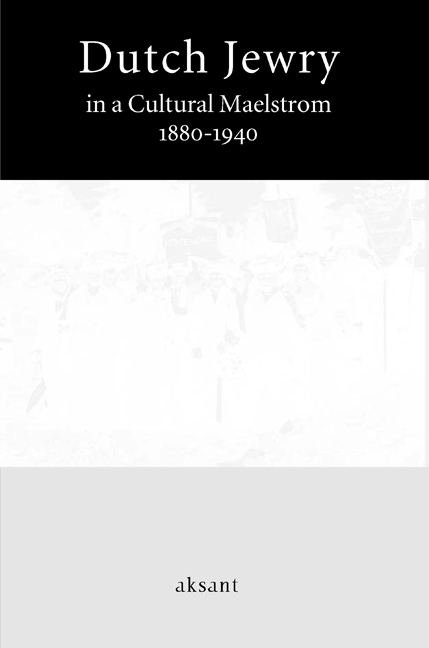Book contents
- Frontmatter
- Contents
- Foreword
- The New “Mosaik”: Jews and European Culture, 1750-1940
- The Politics of Jewish Historiography
- “The First Shall be the Last”: The Rise and Development of Modern Jewish Historiography in the Netherlands Until 1940
- Epigones and Identity: Jewish Scholarship in the Netherlands, 1850-1940
- Judaism on Display: The Origins of Amsterdam's Jewish Historical Museum
- De Vrijdagavond as a Mirror of Dutch Jewry in the Interbellum, 1924-1932
- “Holland is a Country which Provokes Serious Reflection…”: Images of Dutch Jewry in the German Jewish Press
- Spinozism and Dutch Jewry between 1880 and 1940
- Spinoza's Popularity in Perspective: A Dutch-German Comparison
- Mozes Salomon Polak: Jewish “Lerner” and Propagator of Freemasonry, Spiritualism, and Theosophy
- Jewish Women, Philanthropy, and Modernization: The Changing Roles of Jewish Women in Modern Europe, 1850-1939
- Roosje Vos, Sani Prijes, Alida de Jong, and the others: Jewish Women Workers and the Labor Movement as a Vehicle on the Road to Modernity
- Stemming the Current: Dutch Jewish Women and the First Feminist Movement
- Dutch Jewish Women: Integration and Modernity
- Index of Names of Persons
- Index of Subjects
Judaism on Display: The Origins of Amsterdam's Jewish Historical Museum
Published online by Cambridge University Press: 26 January 2021
- Frontmatter
- Contents
- Foreword
- The New “Mosaik”: Jews and European Culture, 1750-1940
- The Politics of Jewish Historiography
- “The First Shall be the Last”: The Rise and Development of Modern Jewish Historiography in the Netherlands Until 1940
- Epigones and Identity: Jewish Scholarship in the Netherlands, 1850-1940
- Judaism on Display: The Origins of Amsterdam's Jewish Historical Museum
- De Vrijdagavond as a Mirror of Dutch Jewry in the Interbellum, 1924-1932
- “Holland is a Country which Provokes Serious Reflection…”: Images of Dutch Jewry in the German Jewish Press
- Spinozism and Dutch Jewry between 1880 and 1940
- Spinoza's Popularity in Perspective: A Dutch-German Comparison
- Mozes Salomon Polak: Jewish “Lerner” and Propagator of Freemasonry, Spiritualism, and Theosophy
- Jewish Women, Philanthropy, and Modernization: The Changing Roles of Jewish Women in Modern Europe, 1850-1939
- Roosje Vos, Sani Prijes, Alida de Jong, and the others: Jewish Women Workers and the Labor Movement as a Vehicle on the Road to Modernity
- Stemming the Current: Dutch Jewish Women and the First Feminist Movement
- Dutch Jewish Women: Integration and Modernity
- Index of Names of Persons
- Index of Subjects
Summary
The Jewish Historical Museum of Amsterdam, currently housed in the former Ashkenazic synagogue complex on Jonas Daniel Meijerplein, was founded in 1930. It was officially opened two years later, on February, 24 1932, in the Weigh House on Nieuwmarkt in Amsterdam. The early history of the Museum has, until now, only been presented summarily. Descriptions have appeared in the various guidebooks published by the Museum and in a book entitled Vier eeuwen Waterlooplein, which appeared in 1987. My research in the archives of the Amsterdam municipality's art department, of Amsterdam's Ashkenazic community, the Jewish and non- Jewish press, and various museum catalogues has enabled me to trace the museum's development and function up to 1940 with reasonable accuracy.2 But because no prewar museum archive remains – it was presumably lost during the war – a highly detailed reconstruction has not been possible. The information that has come to light about the history of the museum provides new scope for research, particularly the links with Jewish museums elsewhere in Europe, as well as social, academic, and cultural developments in the Jewish community in the Netherlands.
EMANCIPATION AND AN INTEREST IN JEWISH CULTURAL HISTORY
In the second half of the nineteenth century, Jewish emancipation and the subsequent secularization resulted in a growing historical interest in the material objects of Jewish culture. For many, ritual objects used in the synagogue and the home had lost their religious significance and had become (historical) artifacts. One of the earliest collections of Judaica was amassed by Isaac Strauss (1806-1888), a French Jew who left his native Strasbourg in search of art throughout Europe. The Shabbat candlesticks, Kiddush cups, manuscripts and other ritual objects he acquired probably brought back memories of his youth and reconfirmed his Jewish identity. Strauss's presentation at the World Exposition in Paris in 1878 was the first private collection of Jewish ritual objects to be publicly displayed.
In Holland, this collection of ritual objects assembled and presented by a Jewish collector outside a religious context, was considered remarkable. Meijer Roest, librarian of the Bibliotheca Rosenthaliana and editor of De Israelietische Nieuwsbode, called the show “a curious and exceedingly rich collection of artistic objects relating to Jewish prayer in public and in the home…”.
- Type
- Chapter
- Information
- Dutch Jewry in a Cultural Maelstrom, 1880-19401880-1940, pp. 67 - 84Publisher: Amsterdam University PressPrint publication year: 2008

